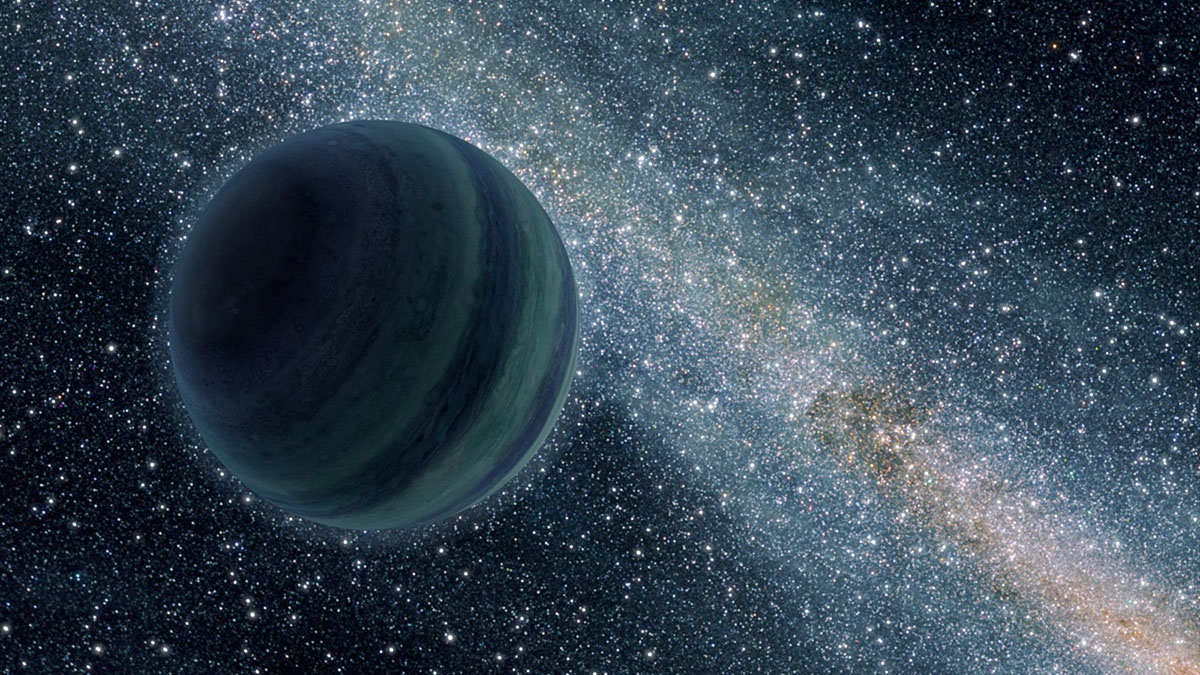how to keep your ocean in interstellar space

If you think of a solar system as a stellar family, you should probably be aware that this sort of family is highly dysfunctional, especially in its early years. Planetoids viciously slam into each other, and gas giants can and do throw out smaller, rocky worlds when they settle into eccentric orbits. When the solar system finally begins to settle down, it’s made up of survivors and a few of the star’s children may be ejected into interstellar space to wander the cosmos for eons to come, bombarded by sterilizing cosmic rays and with atmospheres frozen solid without the heat of a star. Maybe one day they’ll fly by stars at just the right angle to be captured and orbit their adopted sun until it dies. But odds are that they’re probably going to remain frozen spheroids of ice that haunt the voids between stars. Surely they’re doomed to lead a dark and lifeless existence, illuminated only once in a great while by a passing sun, never hosting so much as a bacterium, right? Well, maybe these odd outcasts aren’t doomed to be icy, lifeless rocks after all. Depending on how their atmospheres will freeze and the compositions of their innards, they may just be home to a stealthy ecosystem fed by their cores’ heat.
Of course there are some significant catches for that to happen. An interstellar alien biosphere would have to start on a planet already somewhat hospitable to life and rich with water and carbon dioxide. Ideally, a planet ejected from its solar system would already have given rise to primitive bacteria and as it drifts outward, it will get colder and colder at what we would consider an alarming rate, but to which bacteria could well adapt. As the atmosphere and several kilometers of ocean freeze into a thick, radiation resistant shell, the bacteria still have places to live, especially if they travel deeper towards the ocean floor, where the thermal vents will keep ejecting plenty of energy and nutrients to sustain vast colonies, and maybe even multi-cellular life, much like we see on our very own planet around deep sea volcanic smokers. As long as the planet itself is volcanically active, it could use the heat generated by the decay of naturally occurring radioactive isotopes of elements like potassium, uranium, and thorium in its core to warm deep oceans covered by thick layers of ice, which would act a insulators and create some convection, helping to stir up life-sustaining nutrients floating in the ocean’s layers. Depending on the size of the planet, the radioactive decay could keep the oceans hospitable for one to five billion years, putting it in the same league with many planets still orbiting their stars.
So how big should a planet be to stay warm even after it’s been sent out of its solar system? If it has a similar composition to Earth, it should ideally be about 3.5 times as massive. That extra heft means more rock to act as an insulator for the decay of potassium-40, uranium-238 and thorium-232, a thicker blanket of ice on top, and more water to contain an active biosphere. But if a planet’s atmosphere is rich with carbon dioxide, it can reach its steady state easier and could theoretically be as small as 0.3 Earth masses while still holding on to a warm and hospitable ocean. Of course warm is somewhat relative in this case because the steady state in question is 260 K, or -13.5 °C at the point between the end of the ice sheet and the top layer of the ocean. For a balmy world like ours that’s pretty cold, but it’s certainly not bad at all for a sun-less planet barreling through interstellar space, keeping its water liquid by pressure and bottom-up convection. And considering that it will also spew countless tons of nutrients and emit plenty of heat from its volcanic vents, we might even go as far as trying to guess whether life could evolve on a rogue planet after it’s been ejected. Since all the basics for a biosphere would already be there, right at the warm and nutrient-rich bottom of its oceans, couldn’t life stand a decent chance of appearing and thriving like it has in similar conditions here on Earth? Creatures like worms and nematodes, along with alien equivalents to arthropods could certainly call a place like that home.
However, there’s a little twist to consider. Imagine a super-Earth with an extremely deep ocean, much deeper than anything we will see in our solar system, and suspect may be on the ocean floor of planet GJ 1214b if it is an ocean world like we think. The immense pressures at the sea bed could exceed 80,000 atmospheres, or about 1.1 million psi, forming an exotic form of matter known as Ice VII. With deep enough oceans, water can be compressed to a near-solid state and make it extremely difficult, if not virtually impossible, for life to evolve around nutrient rich vents, or restrict it to liquid layers which would have access to volcanic vents at a far lower depth, where water could still be warmed and convection can occur. It would be an unusual scenario since it means that a frozen world up to 7 Earth masses wandered close enough to its parent sun to melt more than hundred miles of ice and create an extremely thick, water vapor rich atmosphere which would cause a strong greenhouse effect, then somehow get ejected from the system and have that thick atmosphere freeze over its surface. But it is a plausible scenario, and in a universe where we might find alien life on a rogue interstellar snowball of a world, it probably wouldn’t be the weirdest thing that might’ve happened…
See: Dorian S. Abbot, Eric R. Switzer (2011). The Steppenwolf: A proposal for a habitable planet in interstellar space submitted to Astrophysical Journal Letters arXiv: 1102.1108v1





